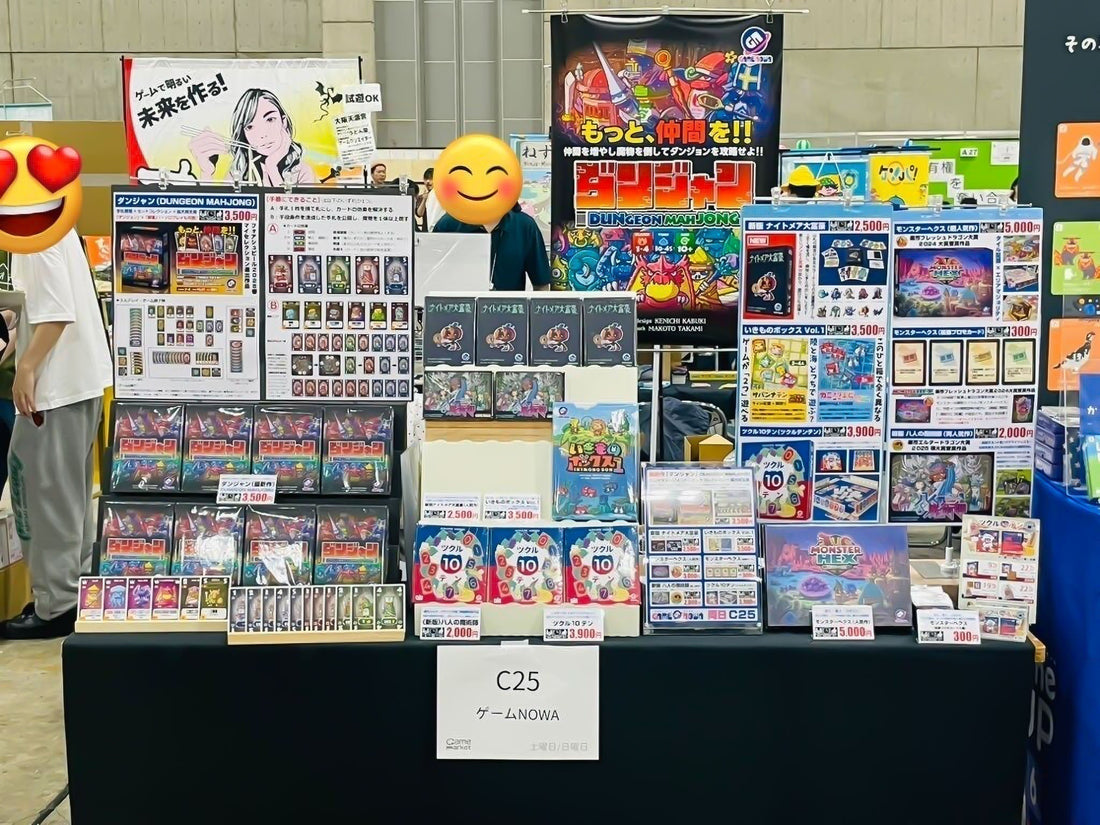
Voices of Japanese Creators: Game NOWA's Kenichi Kabuki
Last time on our "Voices of Japanese Creators" series, we spoke with a creator who until recently had never even considered making a game before. It's incredible to see how quickly the path from inspiration to completion can be when a new passion is discovered. This series isn't just about new creators though; we also want to bring you comments from established members of Japan's board game community. Today's article is exactly that. Kenichi Kabuki, or as he's often referred to in Japanese board game circles, Kabuken (remember the first and last name order is different in Japan), has been participating in Game Market as an independent creator for years now.
 Dungeon Mahjong, Kenichi Kabuki's latest work
Dungeon Mahjong, Kenichi Kabuki's latest work
Prior to this year's Game Market, he showed the INTL team his new work: Dungeon Mahjong (or ダンジャン, Danjan, in Japanese), shown above. We were impressed by his excitement and the energy he brought to the table when going over the game, explaining how it was different from normal mahjong, and where it was more faithful to the original. I particularly liked the idea behind it - defeat monsters using mahjong-style melds to recruit them as allies, then use your combined strength to take down endgame bosses called the Demon Lords. It's very RPG-like; you can feel yourself growing tangibly stronger throughout the game without losing the combinations that are the essence of mahjong. It's also simple to play, with an art style that might pull in players who wouldn't normally be interested in mahjong.
In discussing his production process with us, he mentioned some difficulties he had that sparked my desire to get comments from him even more. I don't want to give too much away, but he ended up needing to use a completely separate printing process for some of his cards! Let's go ahead and get right into our questions and Kenichi's comments on the Spring 2025 Game Market, his games, and the manufacturing process for Dungeon Mahjong!
What was your experience like at this year’s Spring Game Market?
For the past few events, whenever we had a new game to showcase, we always made sure to create a promotional video in advance. However, this time, we ended up spending so much time fine-tuning the new game that we had to attend the event without a PV. That said, we had received positive feedback during a pre-event playtesting session, which helped the game gain recognition as one of the more noteworthy titles. While we didn’t sell out, I was glad that many people still picked it up.
How many times have you attended Game Market? What changes have you noticed over the years?
Counting from my first time at Game Market Osaka in 2012, I’ve participated 38 times in total. In recent years, I’ve especially noticed a sharp increase in the number of participating circles and a big leap in the visual quality of games. I also feel that promotional activities have become much more important.
What do you think gives your games a unique or personal touch?
Most of the games I enjoy playing myself are light to medium-weight games for casual players, so I aim to create games that are approachable, with minimal rules, but still have some unique quirks. I’m known for “tile-laying” and “area control” types of games, and I hope to continue developing in those genres. That said, I also love mahjong-style and daifugō-style games (and this spring there were a ton of those), so I want to keep creating in those areas as well.

One side of the Dungeon Mahjong booth at the Spring 2025 Game Market
Could you tell us about the development process of your latest title, Dungeon Mahjong?
Dungeon Mahjong initially started as a mix between “Mahjong × Sugoroku,” but before even worrying about whether it was fun or not, I found that the poor pacing was a big issue, so I scrapped that combination pretty early on.
From there, I made the following key changes:
- I reduced the number range from 1–7 down to 1–5, and removed the Mahjong-style “pair” requirement (two identical tiles of the same suit).
- Made it so players build up to three sets of 3-card combos (either same-number same-color, or same-color in sequence).
- Adapted the original board space effects into a mechanic where, at the start of your turn, you discard one number card to trigger effects like number adjustment, color change, drawing a card from the table, or drawing two from the deck.
- Most importantly, I made it a game where players feel the thrill of growth by defeating monsters and gaining more cards (allies) to power up their hand.
Were there any challenges during printing or manufacturing?
As for printing issues: There was a limitation on the number of cards we could print at once. On top of that, only the monster cards had different back designs depending on level, while the guild cards (number cards) shared a common back. If we tried printing both on a single sheet, the monster card backs would affect the guild card backs—so printing them separately would increase costs. Thankfully, the printer came up with a layout that minimized the cost impact as much as possible. We also added more types of monsters than originally planned, and we asked the illustrator Takami Makoto to design the status cards, which added to their workload—so I felt a bit bad about that.
You mentioned to us previously that you used a business card printer for the status cards; why did you go with this option?
As for why we used business card printing for the status cards: that was purely for cost-cutting reasons. (Ideally, I would have liked to match the other cards’ material and finish, or even use tiles if we’d had more time and budget.)
Concluding remarks from the INTL team:
Kenichi Kabuki's comments on his participation in this year's Game Market reflect a similar experience to our previously interviewed creator, Ryo Momoido. It seems that in the modern day, promotional videos and social media marketing play a fairly large role in how well a given game will do. In my opinion, social media also plays a role in driving up the average quality of games across the board, especially visually. As more information on game making becomes widely available, more creators can find methods of manufacturing their game that may have been difficult for them to learn about before. Discussing something like this with someone who has participated in Japan's biggest board game event 38 times provides at minimum solid anecdotal evidence for the trend. Of course, I encourage all of our readers to plan a trip to Japan (or at least a local event) around Game Market to test the quality yourself!
The points on the manufacturing process are something that I was initially unaware of before speaking with Kenichi. It seems somewhat obvious in retrospect, but of course print costs would go up if you have different backs for cards printed on the same "sheet." It almost makes me shudder to think about the production cost for games like Paleo, which has a wide array of different backs to act as a hint for what's on the front of each card. Even a smaller scale game like Ghost Snap (we have the Junji Ito version for sale on this site!) has different backs for its photo cards versus its item and anxiety cards to help the player understand that they play different roles in gameplay. Whenever you play a card-based game that has varied backs, briefly take a moment to consider the impact that may have had on your wallet!
The part that I found the most fascinating, however, was Kenichi's creative use of a business card printer for some of the cards in his game. As discussed previously, different card types can be quite expensive to print on one sheet, and there's also a limit to how many cards you can fit on a given sheet at a time. In his original discussion with the INTL team, Kenichi mentioned how adding the extra monster cards in put an additional burden on not just the artist, but also the printing cost - all this on top of already having cards with different backs! In order to lessen the impact on price and to save space on the printing sheets, Kenichi utilized a business card printer for certain less important cards. The quality was good enough that no one on the INTL team noticed when Kenichi initially discussed his game with us, while still being cost effective.
The main takeaways for aspiring game creators are threefold: first, utilize social media to both see what others are working on and to promote your own game. Second, learn as much as you can about the manufacturing process so you'll have an idea of how your component counts will affect your production cost. And lastly, don't be afraid to use out-of-the-box solutions to solve cost or space-related problems!
Thank you so much for reading and stay tuned for future articles in the Voices of Japanese Creators series!

Interviewee: Kenichi Kabuki, Game NOWA
Translation and additional comments by Matthew Moller, JELLY JELLY INTL
